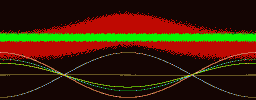An Alfvén wave is a wave that occurs in a plasma (or conducting fluid), resulting from the interaction of the magnetic fields and electric currents within it, causing an oscillation of the ions. Alfvén wrote in a letter to the journal Nature in 1942:
- “If a conducting liquid is placed in a constant magnetic field, every motion of the liquid gives rise to an E.M.F. which produces electric currents. Owing to the magnetic field, these currents give mechanical forces which change the state of motion of the liquid. Thus a kind of combined electromagnetic-hydrodynamic wave is produced.”[1]
Alfvén waves initiated the field of magnetohydrodynamics which subsequently earned Alfvén a Nobel Prize.
History
Historical background: see “Alfvén Waves” (p.653) in “Biographical Memoirs: Hannes Alfvén” (PDF), Proceedings American Philosophical Society, Vol. 150, 4 (December 2006) by C.G. Fälthammar, Alex Dessler
Timeline
- 1942: Alfvén theorises the existence of electromagnetic-hydromagnetic waves in a paper published in Nature.[1]
- 1949: Laboratory experiments by S. Lundquist produce such waves in magnetised mercury, with a velocity that approximated Alfvén’s formula.[2]
- 1949: Enrico Fermi uses Alfvén waves in his theory of cosmic rays. According to Alex Dressler in a 1970 Science journal article, Fermi had heard a lecture at the University of Chicago, Fermi nodded his head exclaiming “of course” and the next day, the physics world said “of course”.[3]
- 1950: Alfvén publishes the first edition of his book, Cosmical Electrodynamics, detailing hydromagnetic waves, and discussing their application to both laboratory and space plasmas.[4]
- 1952: Additional confirmation appears in experiments by Winston Bostick and Morton Levine with ionized helium.[5]
- 1954: Bo Lehnert produces Alfvén waves in liquid sodium.[6]
- 1955: Eugene Parker suggests hydromagnetic waves in the interstellar medium.[7]
- 1958: Berthold, Harris, and Hope detect Alfvén waves in the ionosphere after the Argus nuclear test, generated by the explosion, and travelling at speeds predicted by Alfvén formula.[8]
- 1958: Eugene Parker suggests hydromagnetic waves in the Solar corona extending into the Solar wind.[9]
- 1959: D. F. Jephcott produces Alfvén waves in a gas discharge.[10]
- 1960: Coleman, et al, report the measurement of Alfvén waves by the magnetometer aboard the Pioneer and Explorer satellites.[11]
- 1960: Sugiura suggests evidence of hydromagnetic waves in the Earth’s magnetic field.[12]
- 1970 Hannes Alfvén wins the 1970 Nobel Prize in physics for “for fundamental work and discoveries in magneto-hydrodynamics with fruitful applications in different parts of plasma physics“.[13]
- 1973: Eugene Parker suggests hydromagnetic waves in the intergalactic medium.[14]
- 1974: Hollweg suggests the existence of Hydromagnetic waves in interplanetary space [15]
- 1974: Ip and Mendis suggests the existence of Hydromagnetic waves in the coma of Comet Kohoutek.[16]
Notes
- ↑ 1.0 1.1 Hannes Alfvén, “Existence of electromagnetic-hydrodynamic waves“, Nature, Vol. 150, pp. 405, 3 Oct 1942 (Full text)
- ↑ Lundquist, S., “Experimental Investigations of Magneto-Hydrodynamic Waves“, Physical Review (1949), vol. 76, Issue 12, pp. 1805-1809 PEER REVIEWED
- ↑ Dessler, A. J., “Swedish iconoclast recognized after many years of rejection and obscurity,” Science (1970) , vol. 170, p. 604 PEER REVIEWED
- ↑ Hannes Alfvén, Cosmical Electrodynamics, International Series of Monographs on Physics, Oxford: Clarendon Press, 1950 ACADEMIC BOOK. See also the later 1963 2nd edition co-authored with Carl-Gunne Fälthammar
- ↑ Bostick, Winston H.; Levine, Morton A., “Experimental Demonstration in the Laboratory of the Existence of Magneto-Hydrodynamic Waves in Ionized Helium“, Physical Review (1952), vol. 87, Issue 4, pp. 671-671 PEER REVIEWED
- ↑ Lehnert, Bo, “Magneto-Hydrodynamic Waves in Liquid Sodium“, Physical Review (1954), vol. 94, Issue 4, pp. 815-824. PEER REVIEWED
- ↑ Eugene N. Parker, “Hydromagnetic Waves and the Acceleration of Cosmic Rays“, Physical Review (1955), vol. 99, Issue 1, pp. 241-253. PEER REVIEWED
- ↑ Berthold, W. K.; Harris, A. K.; Hope, H. J., “World-Wide Effects of Hydromagnetic Waves Due to Argus” (1960), Journal of Geophysical Research, Vol. 65, p.2233. PEER REVIEWED
- ↑ Parker, E. N., “Suprathermal Particle Generation in the Solar Corona” FULL TEXT, Astrophysical Journal (1958), vol. 128, p.677 PEER REVIEWED
- ↑ Jephcott, D.F., “Alfvén waves in a gas discharge“, Nature, (1959) vol.183, p.1653. PEER REVIEWED
- ↑ Coleman, P. J., Jr.; Sonett, C. P.; Judge, D. L.; Smith, E. J., “Some Preliminary Results of the Pioneer V Magnetometer Experiment“, Journal of Geophysical Research (1960), Vol. 65, p.1856. PEER REVIEWED
- ↑ Sugiura, Masahisa, “Some Evidence of Hydromagnetic Waves in the Earth’s Magnetic Field“, Physical Review Letters (1961), vol. 6, Issue 6, pp. 255-257 PEER REVIEWED
- ↑ Hannes Alfvén, “Nobel Lecture” FULL TEXT, nobelprize.org
- ↑ Parker, E. N., “Extragalactic Cosmic Rays and the Galactic Magnetic Field” FULL TEXT, Astrophysics and Space Science (1973), Vol. 24, p.279 PEER REVIEWED
- ↑ Hollweg, J. V., “Hydromagnetic waves in interplanetary space“, Astronomical Society of the Pacific, Publications (1974), vol. 86, Oct. 1974, p. 561-594. PEER REVIEWED
- ↑ Ip, W.-H.; Mendis, D. A., “The cometary magnetic field and its associated electric currents“, Icarus (1975), vol. 26, Dec. 1975, p. 457-461. PEER REVIEWED
